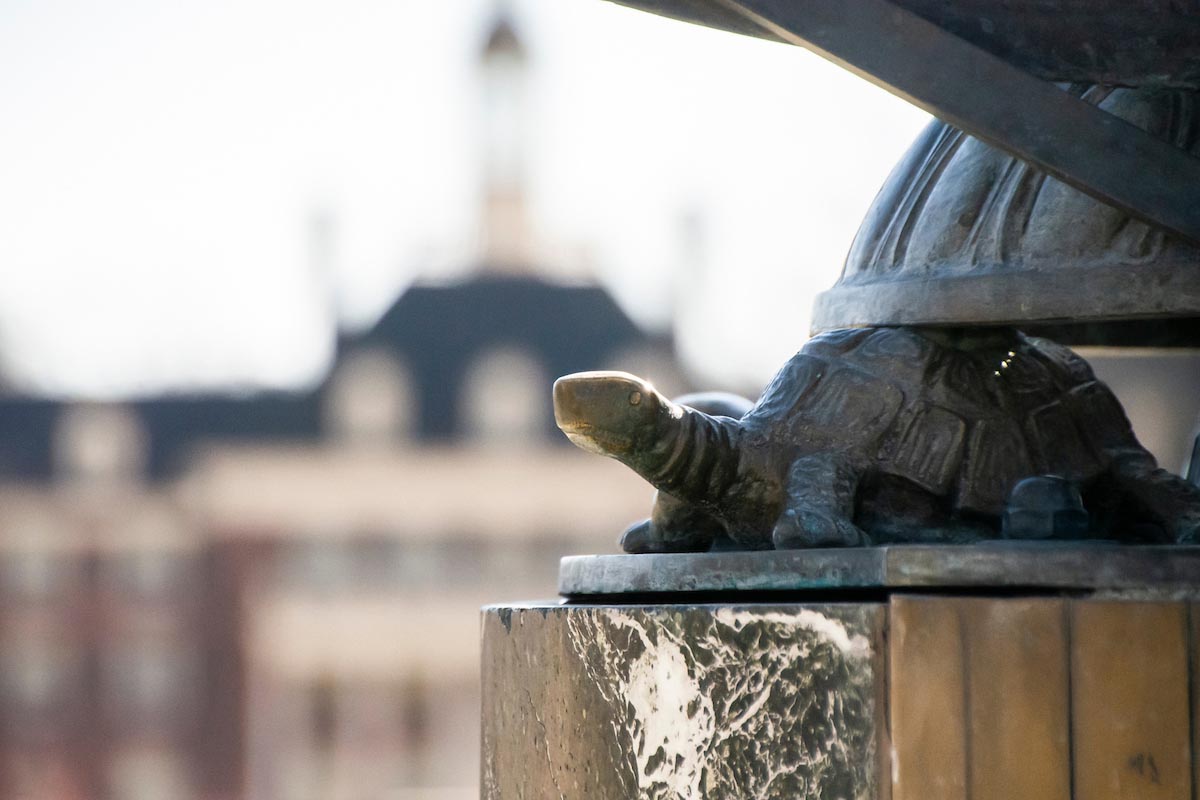
Our History and Traditions
Take some time to learn how Miami University of Ohio came to be, and about the campus traditions we continue to uphold.
Miami's Will Goes Way Back
As one of the country's first public universities, Miami University was made possible by a law that President George Washington signed in 1795. Our institution was officially chartered in 1809 and welcomed its first students in 1824.
In the following years, Benjamin Harrison would attend, graduate, and go on to serve as the 23rd President of the United States. Another notable alumnus is Professor William Holmes McGuffey, who taught at Miami from 1826 to 1836. During this time, he performed research for his Eclectic Readers series, which would revolutionize education for generations of Americans.
In the years that followed, Miami's reputation grew as quickly as its enrollment. Once referred to as the "Yale of the West" for its ambitious liberal arts curriculum, Miami consistently ranks among the nation's top public universities for the quality of teaching and overall student experience.
"Great Lives Never Go Out; They Go On."
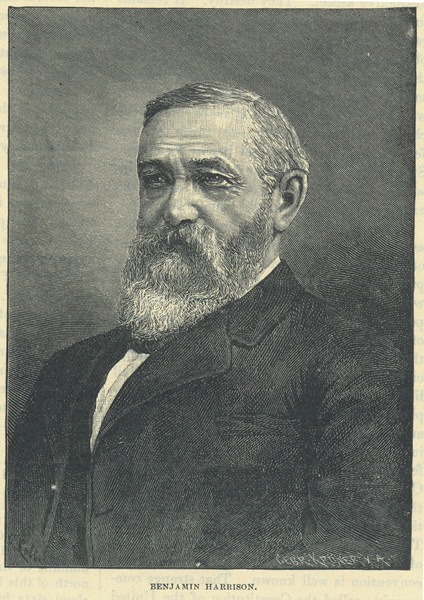
McGuffey and His Readers
Professor William Holmes McGuffey, who taught at Miami from 1826 to 1836. revolutionized education with his Eclectic Readers' series, also known as the McGuffey Readers. They were first published in 1836 and used as textbooks across the United States for about 100 years. By the end of the 19th century, more than 100 million copies were printed and sold.
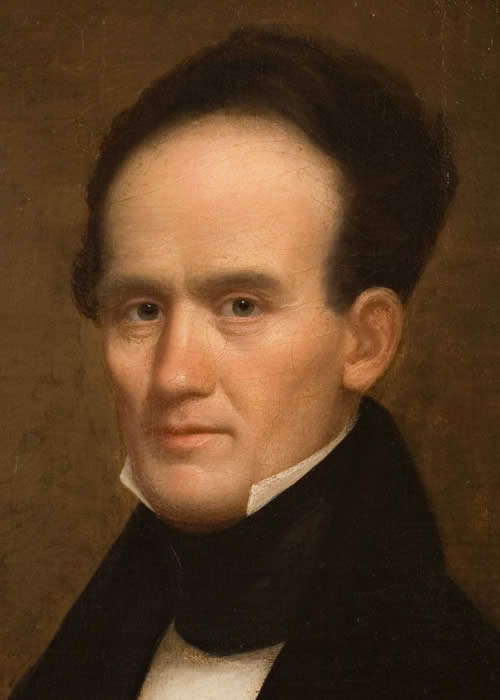
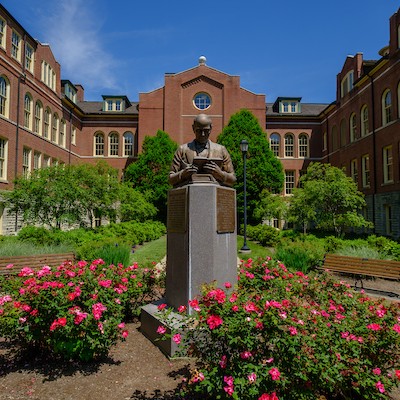
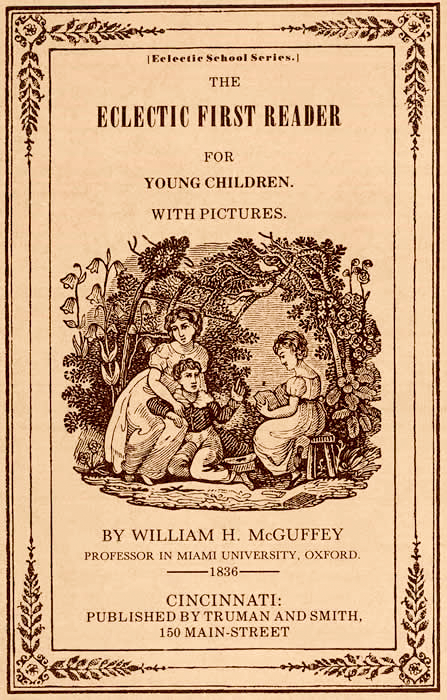
Inspiring Future Generations
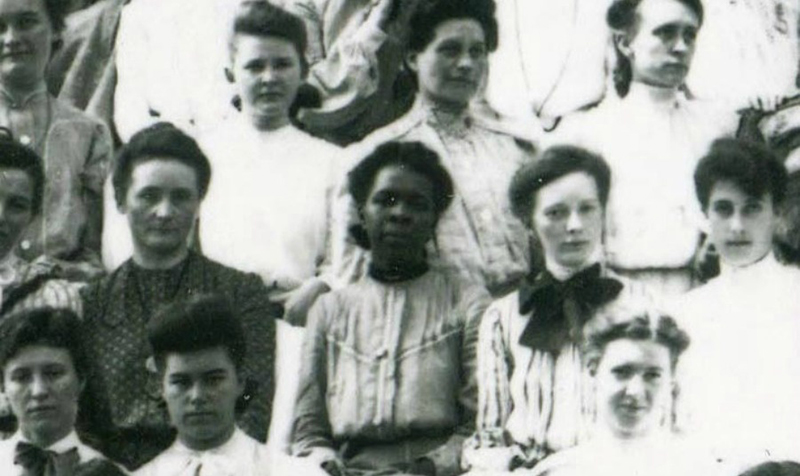
Traditions That Make Miami Unique
Some fun, some serious. All built to last forever.
Rub the turtle's heads and get a healthy dose of good luck, or walk on the seal and you're going to fail your next exam.
Freedom Summer '64
Freedom Summer was a 1964 voter registration drive in Mississippi, led by CORE and SNCC to increase Black voter participation. Though SNCC planned to recruit 100 white students, hundreds joined. Volunteers trained June 14–27 at Western College for Women in Oxford, Ohio (now part of Miami University).
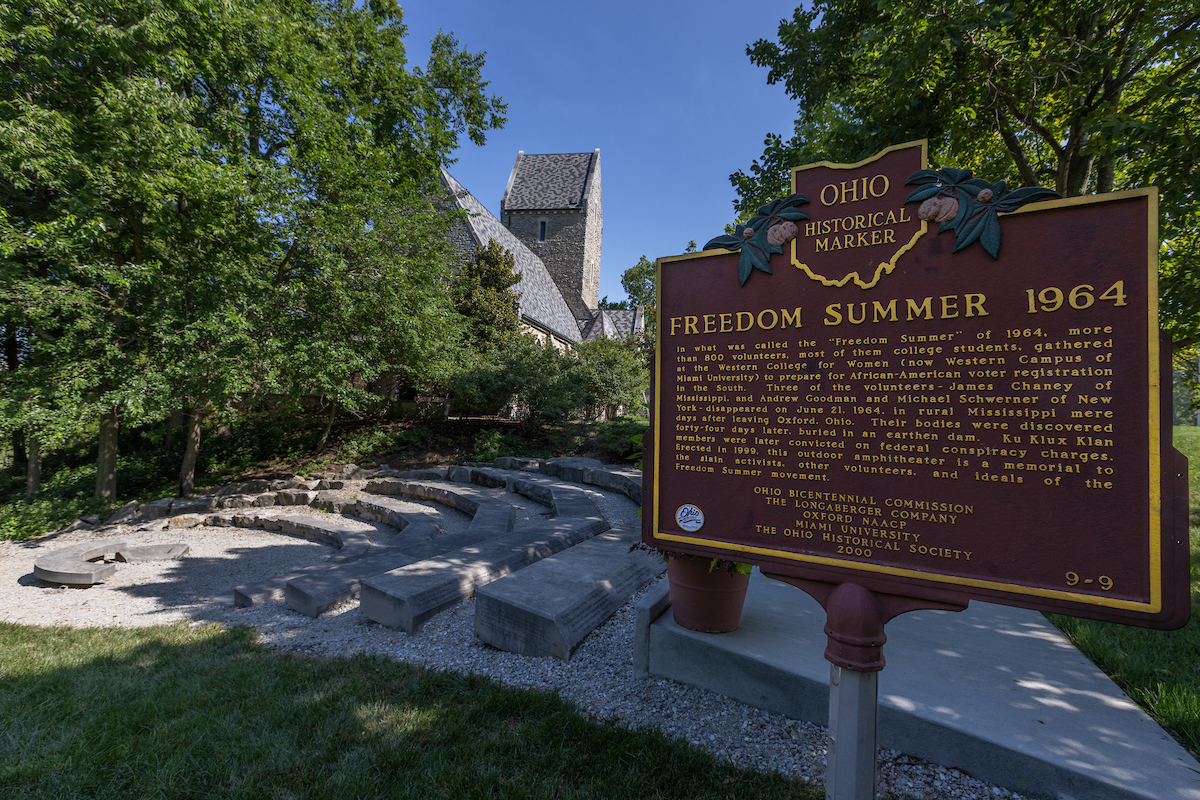
A Model of Public Higher Education for Over Two Centuries
From our start in the early 19th century as a small midwestern college to our transformation into a 21st century international university, Miami University has stood for two centuries as a model of public higher education. Miami University 1809-2009, Bicentennial Perspectives, a historical timeline spanning five different eras of campus life, shows how national social forces and academic culture interacted in the college town of Oxford, Ohio.
Inventing College Life
1787
- July 13, Northwest Ordinance passed by Continental Congress
- September 17, United States Constitution written; ratified 1788
1794
- September 30, President George Washington signs patent for Symmes Purchase
1795
- August 3, Miami Tribe signs Treaty of Greenville
1803
- September 1, commissioners of the legislature locate the Miami College township on public lands in the Cincinnati district
1809
- February 17, the Miami University chartered by State of Ohio
1810
- Village of Oxford laid out in the college township; Miami University campus surveyed
1811
- Log schoolhouse erected on University Square to serve Oxford Township
1816
- Construction of first classroom building, Franklin Hall (later part of Old Main), begun
1822
- Proposed relocation of Miami University to Cincinnati defeated in legislature
1824
- President Robert Hamilton Bishop inaugurated; classes begin
1825
- Erodelphian Literary Society and Union Literary Society organized
1828
- First residence hall, North Hall (later Elliott Hall), constructed
1835
- Chapter of Alpha Delta Phi fraternity established
1836
- William Holmes McGuffey publishes his first Eclectic Reader
- Second residence hall, South Hall (later Stoddard Hall), constructed
1838
- Oxford Theological Seminary established
1839
- Alpha chapter of Beta Theta Pi fraternity founded
1841
- President George Junkin inaugurated
1842
- President Junkin issues Laws of Miami University for Government of the Faculty and Students
1844
- President Junkin resigns following student disruptions
1845
- President Erasmus D. MacMaster inaugurated
1846
- Conflict among literary societies, board, and faculty
- Miami Tribe removed from traditional lands to western territories
1848
- January 12, Old Main sealed with snow, seventeen students dismissed or depart
- December 27, Alpha chapter of Phi Delta Theta fraternity founded
1849
- President MacMaster resigns
- President William C. Anderson inaugurated; joins Phi Delta Theta fraternity
- Oxford Female Institute (later Oxford College) chartered; John W. Scott, principal
1852
- Chapter of Delta Kappa Epsilon fraternity established
1853
- Western Female Seminary (later Western College) chartered; Helen Peabody, principal
1854
- Oxford Female College chartered; John W. Scott, principal
- President John W. Hall inaugurated
1855
- Alpha chapter of Sigma Chi fraternity founded
1859
- Junction Railroad reaches Oxford
1861
- April 12, American Civil War begins
- Ozro Dodds, student, and Professor Robert W. McFarland form volunteer companies for Union
1866
- President Robert L. Stanton inaugurated; seeks new funding sources for Miami
1871
- Andrew D. Hepburn named president
1873
- National financial panic, low enrollment, no endowment; trustees suspend operation
1873–1885
- Miami Classical School and Miami Classical and Scientific Training School operate on campus
1885
- President Robert W. McFarland takes office; Miami reopens classes
Embracing Professionalism
1885
- Miami reopens; Robert White McFarland (1885–88) assumes the presidency
1886
- Oxford Female College confers baccalaureate degrees
1887
- Five women admitted as "special students" by trustee resolution of June 21
1888
- Ethelbert Dudley Warfield (1888–91) assumes the presidency
- First football game played, against University of Cincinnati
1891
- William Oxley Thompson (1891–99) assumes the presidency
- Miami admits seventeen women students
1892
- Brice Hall, first donated building, constructed for science instruction; Calvin Brice, donor
- Alumnae Hall built at Western College, James Renwick Jr., architect; Olivia Meily (Mrs. Calvin) Brice, donor
1895
- Miami builds a baseball field
- Western College and Seminary confers baccalaureate degrees
1896
- Miami Field constructed for football
- Sleeper Bill provides first regular annual appropriation from State of Ohio
1897
- Herron Gymnasium (later Van Voorhis Hall) constructed
1899
- David Stanton Tappan (1899–1902) assumes the presidency
1900
- Three of sixteen women at Miami awarded bachelor's degrees
1902
- The Ohio State Normal College established in Oxford
- Guy Potter Benton (1902–11) assumes the presidency
- Delta Zeta, a fraternal organization for women, founded
1903
- Nellie Craig, first African American woman, enrolls; earns Normal College diploma in 1905
1905
- Hepburn Hall constructed as first residence hall for women
1908
- New Administration/Auditorium Building (later Benton Hall, Hall Auditorium) constructed
1909
- First Alumni Campaign matches a Carnegie Award to build Alumni Library
- South Pavilion, Normal College (later McGuffey Hall), constructed
1910
- Earl Kelley, first identified male African American enrolled (1902), earns Normal College diploma
1911
- Raymond Mollyneaux Hughes (1911–27) assumes the presidency
1912
- Bishop Hall constructed as residence for women
1917
- United States enters World War I
1919
- Miami "No-Horse Rule" replaced by "No-Car Rule"
1923
- Wells Hall constructed as residence for women
1924
- University Hospital (later MacMillan Hall) constructed
- Ogden Hall constructed as residence for men, and student center
- New Freshman Dormitory (later Swing Hall) constructed as residence for men
1925
- Oxford Retreat main building (former Oxford Female College) purchased, renamed Fisher Hall
- Irvin Hall, first fully neo-Georgian classroom building, constructed as recitation building
1928
- Alfred Horatio Upham (1928–45) assumes the presidency
- School of Business Administration (later Farmer School of Business) founded, located in Irvin Hall
- Oxford College for Women acquired; main building renovated for women's residence
1929
- School of Fine Arts founded
1931
- Center section, Hughes Hall (later Kreger Hall), constructed for chemistry
- Withrow Court constructed for men's athletics and physical education, and assembly hall
1937
- North and South dormitories renovated in neo-Georgian style, named Elliott Hall and Stoddard Hall
1939
- New Freshman Dormitory Number One (later Symmes Hall) constructed for men
1940
- North Residence Hall (later Hamilton Hall) constructed as residence for women
1941
- South Hall (later Richard Hall) constructed as residence for women
- Beta Theta Pi Campanile constructed
Expanding Access
1941–1945
- December 7, 1941, Pearl Harbor Naval Station attacked; United States enters World War II
- War depletes civilian enrollment, military training schools prepare 10,000 recruits and reserves
1945
- President Alfred H. Upham dies in office; A. K. Morris, acting president, 1945– ;46
1946
- Ernest H. Hahne (1946–52) assumes the presidency; "Veterans' Village" ("Vetville") erected
- Graduate School established as a separate academic division
1947
- John E. Dolibois named executive secretary of Miami Alumni Association
1949
- Reid Hall residence for men, Rowan Hall Naval ROTC building constructed
- Upham Hall center section (humanities) constructed; north wing, 1950, and south wing , 1965 (natural sciences)
1950
- WMUB FM Radio founded
1952
- President Hahne dies; Clarence W. Kreger, acting president, 1952–53
- Billings Natatorium, Collins and McBride residence halls constructed; Tallawanda Hall (1908) acquired
1953
- John D. Millett (1953–64) assumes the presidency
1954
- East Dining Hall (later "East End") constructed by Armco Steel with two cafeteria lines to serve 700
1956
- Porter residence hall, Administration Building (later Roudebush Hall) constructed
1957
- Work begins on Dennison (1958), Center (later MacCracken, 1961), Scott (1957) residence halls
- University Center (later Phillip R. Shriver Center) constructed
1958
- Sesquicentennial celebration year, 1958–59; Old Main (old Harrison Hall) demolished
- Walter Havighurst publishes The Miami Years (revised 1969 and 1984)
- Hiestand Hall (School of Fine Arts), Miami Manor (married student housing) constructed
1959
- School of Applied Science founded; Dean of Educational Services created
- Senator John F. Kennedy speaks at Miami Field; Martin Luther King, Jr. speaks in University Center
- McGuffey House (1833) acquired for museum; designated National Historic Landmark, 1966
- Bishop Memorial Gates; Sesquicentennial Chapel; Brandon, Dennison north wing, McFarland residence halls constructed
- February 17, "Sesquicentennial Convocation" marks Miami's first formal Charter Day
- Laws Hall (business administration), Williams Hall (WMUB studios, communication) constructed
1960
- Harrison Hall (social sciences) on site of Old Main, John W. Browne Stables constructed
1961
- Anderson, Dodds, Stanton, MacCracken (addition) residence halls; Harris, Erickson dining halls constructed
- Culler Hall (natural sciences) constructed
1962
- Edwin Fulwider's Biography of a University mural created for University Center Heritage Room
- Delta Delta Delta Sundial constructed
- Dorsey, Minnich residence halls; Warfield Hall (Student Affairs) constructed
- Phillips Hall (physical education), MacMillan Hospital center wing constructed
1964
- John D. Millett resigns presidency, named first chancellor of Ohio Board of Regents
- Mississippi Summer Project student volunteers train on Western College campus
1965
- Phillip R. Shriver (1965–81) assumes the presidency
1966
- Miami University Middletown founded
- Flower, Hahne residence halls; King Library phase one constructed
1967
- Shideler Hall (geography and geology), Murstein Alumni Center constructed
1968
- Miami University Hamilton founded
- Miami European Center (named for John E. Dolibois, 1988), opened
- Benton Hall (psychology), Millett Hall (assembly hall, sports arena) constructed
1969
- Institute for Environmental Sciences founded
- McGuffey Laboratory School, Center for Performing Arts (theatre and music) constructed
- Emerson and Morris residence halls constructed
1970
- Tappan residence hall, Hughes Laboratories (chemistry) constructed
- April 15, Rowan Hall occupied by war protesters and Black Student Action Association, 176 arrested
- April 16, strike called, Oxford Campus; May 4, four students killed by National Guard at Kent State University
- May 7, President Shriver closes Oxford campus; reopens May 17
Cultivating Image
1970
- David G. Brown (1970–82) appointed provost and vice president for academic affairs
1971
- Institute for Environmental Sciences, formed 1969, admits first students
1972
- King Library completed
1973
- Unbeaten Miami football team defeats University of Florida in Tangerine Bowl
- McKie Field constructed for baseball
- Old Manse (1852) acquired (campus ministry, later comparative religion)
1974
- Miami Mission Statement rewritten to emphasize national aspirations
- Western College, Oxford's last educational institution for women, closes, merges with Miami and campus acquired Langstroth Cottage (1856), Peabody Hall (1860/1871), Tenney Gateway (1890s), Alumnae Hall (1892), Patterson Place (1898), McKee Hall (1904), Sawyer Gymnasium (1914), Kelley Studio (1916), Clark Gate (c. 1916), Kumler Chapel (1918), Western Bridges (1920s), Ernst Nature Theatre (1922), Western Steam Plant (1924), Mary Lyon Hall (1925), Western Lodge (1926), Presser Hall (1931), Stancote House (1932), Corson House (1930s), Clawson Hall (1946), Boyd Hall (1947), Alexander Dining Hall (1962), Thompson Hall (1963), Hoyt Library (1971)
1975
- Goggin Ice Arena constructed for hockey and recreational sports
1977
- Multicultural Center opens in Bishop Hall
1978
- Women's Studies first available as a certificate-transcript notation
- Miami Art Museum constructed
1979
- Phillip R. Shriver teaches first course in history of Miami University
- Bachelor Hall constructed (English, mathematics and statistics, speech and hearing clinic)
- "Greening of the Future" Lilly Grant initiates Miami faculty development programs
1981
- Paul G. Pearson (1981–92) assumes the presidency
- A new University Honors Program approved by University Senate with Honors Center in Bishop Hall
1982
- Summer reading program for all entering students inaugurated
- Marcum Conference Center constructed on site of Fisher Hall, former Oxford Female College
1983
- Bob Kurz, Class of 1958, publishes Miami of Ohio: The Cradle of Coaches
- Miami Field Gates relocated to newly constructed Yager Stadium
- Walter and Marian Boyd Havighurst Hall constructed on Western Campus
1984
- 175th Anniversary Convocation, Millett Hall
1985
- Richard Moll's The Public Ivys ranks Miami a "Best Buy" for quality
1985–1990
- University Liberal Education Review and Reform Project
- April 6, 1987, "Liberal Education at Miami University: A Statement of Principles" adopted
- February 27, 1989, "The Miami Plan for Liberal Education" adopted by University Senate
- January 1, 1990, University Director of Liberal Education, Liberal Education Council named
1986
- Art Building, Biological Sciences Building (named Pearson Hall 1993) constructed
1987
- Rita Dove, Class of 1973, awarded Pulitzer Prize for poetry
1989
- Myrtis Powell, first African American vice president, named vice president, student affairs
1990
- Number of students living off campus in Oxford surpasses number living on campus
- Miami Metro bus system established
1993
- Paul G. Risser (1993–95) assumes the presidency
1994
- Recreational Sports Center constructed
1995
- December, Risser resigns to become president, Oregon State University
- Provost Anne H. Hopkins becomes first woman to assume acting presidency (1995–96)
Encountering the Education Marketplace
1996
- James C. Garland assumes the presidency
- Health Services Center constructed
- Global Rhythms World Music Ensemble founded
1997
- Responding to the Miami Tribe, trustees change mascot from "Redskins" to "RedHawks"
- Institute for Learning in Retirement established
- No-car rule ends: Seniors allowed to purchase automobile permits; juniors 1998; sophomores 2004
1998
- Oxford water tower demolished
- Campus-wide Institutional Diversity Plan released
- Ditmer Field Parking Lot completed
1999
- Wally Szerbiak scores 43 points defeating Washington in NCAA Basketball Tournament
- Responding to Title IX and President Garland's recommendation, Division I men's soccer, tennis, and wrestling are eliminated
- School of Engineering and Applied Science created from former School of Applied Science
2000
- Responding to Oxford NAACP, President Garland creates Freedom Summer Memorial on Western Campus
- Michael J. Colligan History Project created at Hamilton campus
- Women's Studies becomes a major
- Provost Ronald Crutcher creates First in 2009 Coordinating Council
2001
- Integrated Strategic Plan for the Arts at Miami presented to board of trustees
- Campus Master Plan for 2009 initiated, projecting $500 million of construction
- Verlin Pulley Bell Tower constructed
- MacMillan Hall renovated to create Center for American and World Cultures; opened 2003
2002
- Child Development Center constructed on Western Campus
2003
- PhD Program in Gerontological Studies established
- Vice President for Information Technology position created
- Division I night football first televised on ESPN from Yager Stadium
- Ben Roethlisberger quarterbacks Miami to MAC championship and GMAC Bowl win
2004
- President Garland releases strategic vision statement, First in 2009: The Spirit of a Remarkable University
- Women's precision skating team wins national championship
2005
- For Love and Honor capital campaign announced, with $300 million goal
- Richard T. Farmer designates Miami's largest gift to Farmer School of Business
- Heritage Commons Apartments for students (six buildings) constructed
2006
- Information Technology Strategic Plan creates an entirely wireless campus
- Campus Avenue Garage constructed
- Goggin Ice Arena (1975) demolished, larger Goggin Ice Center constructed near Recreational Sports Center
- Psychology Building constructed, to begin a new academic quad north of High Street
- Trustees terminate the School of Interdisciplinary Studies (Western College Program)
- David C. Hodge assumes the presidency
- For Love and Honor campaign goal increased to $500 million to fund professorships and a Bicentennial Student Center
2007
- Women's Softball Stadium constructed
- School of Engineering and Applied Science facilities constructed in new academic quad
2008
- North Parking Garage completed
2009
- Farmer School of Business facilities completion target
- Voice of America Learning Center for workforce transition completion target, near Interstate 75
